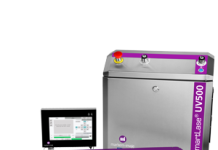Every commercial printer theoretically produces and sells high-quality print. I have never met a printer who said they produce mediocre printing. Thus, if all printers are the same, how do they differentiate? Unfortunately, one of the differentiators tends to be price. This is not good.
There are methods for differentiation. Innovative printers have discovered that they can make money with value-added services. These are ancillary services to printed jobs. The first category of value added services involves finishing enhancement: die cutting, embossing, and coatings.
As someone who judges a large number of printing competitions, I can say that quality is a given. All the entrants produce beautiful printing. But if you analyse the winners, they tend to be printed products with some level of enhancement. These products literally stand out from across the room.
Every offset press comes with a coating unit. Coatings were special at one time, but now they are becoming commonplace on many print jobs. Let us continue to price coating services properly so they are still valued by customers.
Digital printing machines have also implemented enhancement with clear toner. Some can do various levels of coating from dull to gloss, some can print gold and other metallics, fluorescents, and other special effects. Many digital toner printers now come with five instead of the usual four-toner stations. Some go beyond five. HP Indigo can print Pantone colours.
MGI and Scodix offer special inkjet printing systems that can deposit different thicknesses of coloured polymer to create texture and special effects. Think of it as embossing on steroids.
Digital printing can also produce variable data printing, or personalised printing. This should be considered a value-added service. To produce VDP you need a good database and a designer who understands how to integrate personalised text and images. In some cases, the printer is offering these services and they are usually profitable services.
Digital printing and, by extension on-demand printing, gives rise to fulfillment services of many kinds. Printers can maintain small inventories of printed products and produce what is needed as needed. Some printers have also embraced mailing services to sell a complete package.
It all comes down to how customers perceive value. In many cases, print is taken for granted. But certain services are seen as complex or difficult and therefore demand higher value.
Another example is security printing. Protection against forged products and packaging is a worldwide problem. To assure authenticity, taggants (special chemicals) are added to ink that can be deciphered with unique readers. Holograms and embedded images are also used.
Those print service providers with excellent IT capability offer digital asset management and certain Web services. Because marketing is multimedia in nature, printers are providing clients with social media links and e-mail blasts. There are excellent software packages from companies like EFI and others that enable these services. Printers do not have to develop them from scratch.
Some printers also offer advertising specialties, such as caps, pens, cups, etc. Because print is often a promotional item, offering other promotional items makes sense.
I have not included wide format inkjet printing because it is really a new service; although, it has become one of the major sources of new revenue for printers around the world. And mounting, grommets, and sign installation are ancillary services to wide format.
In one study, print service providers that grew 10% or more attributed the highest share of their revenues (26%) to value-added services.
You can read other articles such as this in the Africa Print Journal magazine: https://www.africaprint.com/magazine.





















